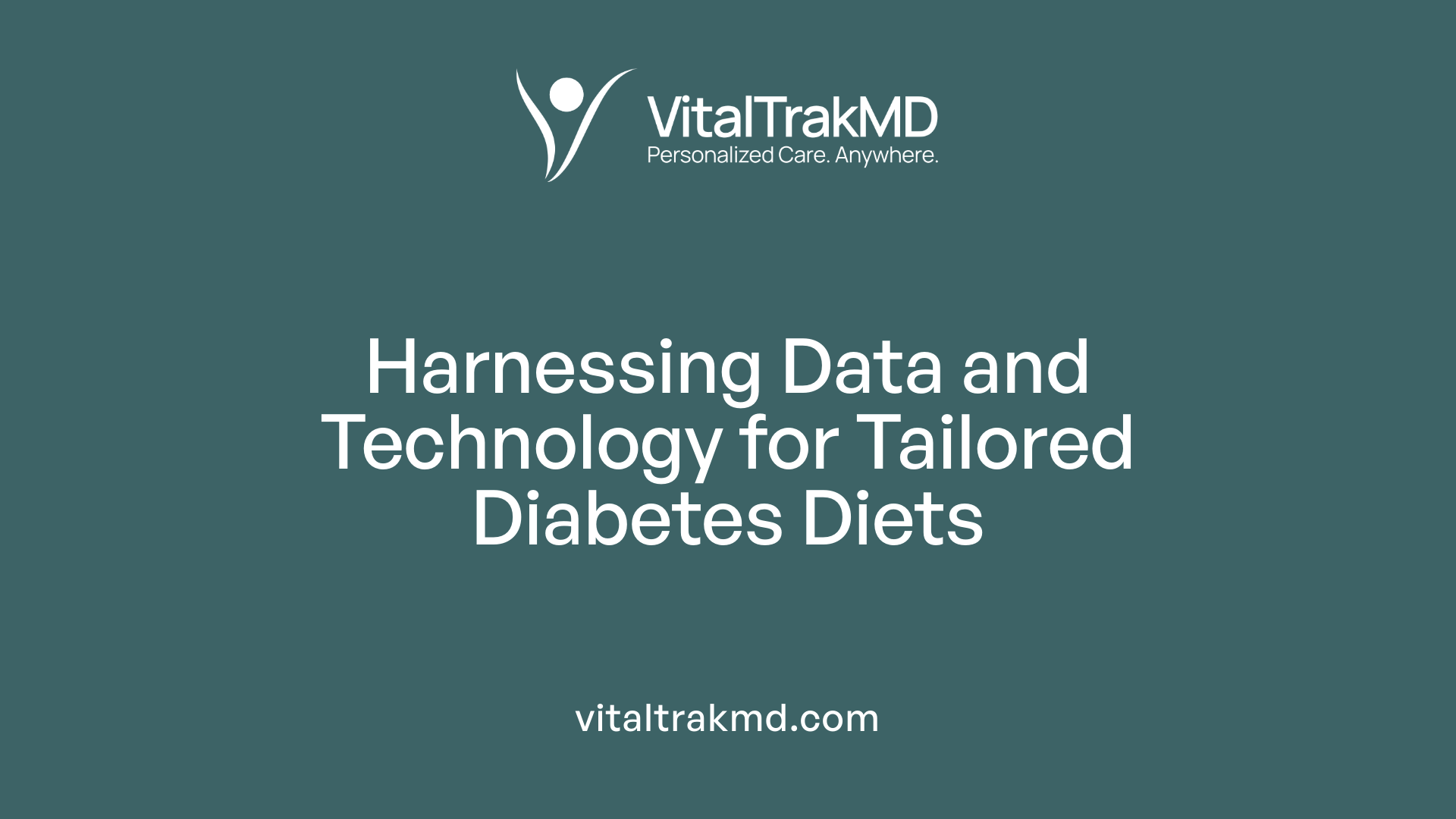Combining Nutrition and Health Support for Diabetic Seniors

Understanding the Complex Needs of Diabetic Seniors
As the aging population grows, the prevalence of diabetes among seniors has risen significantly, presenting unique challenges for healthcare providers, caregivers, and the individuals themselves. Managing diabetes effectively in older adults requires a multidimensional approach that combines tailored nutrition strategies with comprehensive health support. This article explores evidence-based practices, practical approaches, and community resources essential for optimizing health outcomes and enhancing quality of life for diabetic seniors.
Goals of Nutritional Therapy in Diabetes Management
What are the main goals of nutritional therapy for people with diabetes?
The primary aims of nutritional therapy for individuals with diabetes focus on multiple aspects of health management. Firstly, achieving effective blood glucose control is essential to prevent hyperglycemia and reduce the risk of complications. This is often accomplished through a diet that emphasizes steady carbohydrate intake, low glycemic index foods like whole grains, fruits, and vegetables, and appropriate portion sizes.
Maintaining healthy blood lipid and blood pressure levels is another critical goal. Diets rich in high-fiber, plant-based foods, and healthy fats such as those found in fish, nuts, and olive oil, support cardiovascular health. Limiting saturated fats, trans fats, and added sugars helps prevent the development of cardiovascular diseases, which individuals with diabetes are at increased risk for.
Achieving or maintaining a healthy body weight is also vital. Managing weight can improve insulin sensitivity and glucose regulation. Strategies include portion control, reducing calorie intake, and increasing physical activity, all of which support weight management.
The role of specific dietary components is crucial in diabetes management. Emphasizing vegetables, legumes, whole grains, and lean proteins helps stabilize blood glucose levels. Additionally, limiting sugar-sweetened foods, fried items, and processed snacks reduces blood sugar spikes.
In practical terms, consistent meal patterns with evenly spaced carbohydrate consumption prevent large fluctuations in blood sugar. Dietary patterns like the Mediterranean or vegetarian diets can be beneficial, as they promote high fiber, healthy fats, and nutrient-dense foods.
In summary, nutritional therapy aims to promote overall health, support effective glucose and lipid management, and prevent long-term complications such as cardiovascular disease, nerve damage, kidney problems, and eye issues. When combined with physical activity and medication adherence, proper nutrition significantly improves quality of life and disease outcomes for people with diabetes, especially older adults.
Dietary Strategies for Managing Diabetes in Older Adults

What are the key dietary and nutritional strategies for managing diabetes in older adults?
Managing diabetes effectively in older adults involves a balanced and nutrient-rich diet tailored to meet their unique health needs. Emphasizing plant-based foods such as vegetables, fruits, beans, pulses, nuts, seeds, and whole grains can help regulate blood sugar levels while providing vital nutrients like vitamins, minerals, and dietary fiber. These foods are high in complex carbohydrates and low on the glycemic index, promoting slow glucose absorption and stable blood sugar.
Incorporating healthful fats and high-quality proteins is also essential. Foods rich in omega-3 fatty acids, such as fatty fish like salmon and tuna, support heart and brain health. Healthy fats from sources like olive oil, nuts, and seeds can improve lipid profiles. Moderate dairy consumption provides calcium and vitamin D crucial for bone health.
Supporting immune function and cardiovascular health is achieved through a variety of nutrient-dense foods. For example, dark leafy greens (spinach, kale), tomatoes, sweet potatoes, and eggplant are rich in vitamins C and E, potassium, and antioxidants, which help manage blood pressure, reduce inflammation, and enhance immune response.
Adjusting dietary patterns to individual needs involves considering appetite, medical conditions, and cultural preferences. For seniors with a poor appetite, smaller, more frequent meals combined with calorie-dense, nutrient-rich foods can ensure nutritional adequacy. For those managing weight, portion control and limiting foods high in saturated fats, refined sugars, and processed carbs are advised.
In summary, a diet rich in plant-based foods, healthy fats, and lean proteins, with attention to portion sizes and meal timing, can greatly improve blood glucose control, support overall health, and help prevent complications associated with diabetes in older adults.
Evidence-Based Practices for Nutrition and Health Support Integration

What are evidence-based practices for integrating nutrition and health support in diabetic seniors?
Managing diabetes in older adults requires a comprehensive, evidence-based approach that emphasizes personalized nutrition and support strategies. Key practices include creating customized dietary plans that account for each individual’s health status, cultural background, and personal preferences. Clinical studies have shown that nutrition therapy can reduce HbA1c levels by 1-2%, highlighting its importance in blood glucose management.
A focus on nutrient-dense foods—rich in fiber, vitamins, and minerals—is vital. Encouraging the intake of high-fiber foods like vegetables, fruits, legumes, and whole grains helps improve glycemic control. Portion control is also crucial; smaller, more frequent meals can help maintain stable blood sugar levels and manage appetite, especially in seniors with multiple health conditions.
Healthy fats, especially unsaturated fats and omega-3 fatty acids from fish and plant oils, support cardiovascular health and reduce inflammation. Reducing consumption of sugar-sweetened drinks and saturated fats aligns with evidence-based guidelines for diabetes care.
Supporting older adults with education on blood sugar monitoring, behavioral modifications, and integrating community resources enhances adherence to nutritional plans. Technology, such as continuous glucose monitoring (CGM), offers real-time feedback, enabling more precise dietary adjustments.
Furthermore, understanding the social and cultural context allows dietary interventions to be more acceptable and sustainable. Tailoring recommendations—whether through Mediterranean, vegetarian, or culturally specific diets—ensures better engagement and health outcomes.
Overall, combining personalized plans, education, and technology—supported by current clinical evidence—serves as the foundation for effective nutrition and health support in managing diabetes among seniors.
Practical Approaches to Support Healthy Eating and Blood Glucose Control

What practical approaches can help seniors with diabetes maintain healthy eating habits and blood glucose control?
Managing diabetes in older adults requires straightforward, manageable strategies that fit their lifestyle and health needs. Developing simple, balanced meal plans created with the help of a registered dietitian ensures nutritional adequacy while keeping blood sugar levels in check.
One effective method is the Diabetes Plate approach. This visual guide simplifies portion control by filling half the plate with non-starchy vegetables like leafy greens, broccoli, or peppers. A quarter of the plate can be reserved for lean proteins such as chicken, fish, beans, or tofu. The remaining quarter should contain healthy carbohydrate sources like whole grains, fruits, or legumes. This method reduces the need for calorie counting or precise measurements, making healthy eating more accessible.
Consistency in meal timing is also important. Having regular meals spaced 2 to 3 hours apart helps stabilize blood glucose levels throughout the day. Complementing meals with healthy snacks, such as a small handful of nuts with an apple or carrot sticks with hummus, can prevent dips in blood sugar and support overall nutrition.
Monitoring carbohydrate intake is key, especially focusing on complex carbs with high fiber content—these digest more slowly and lead to a gentler rise in blood glucose. Reading food labels carefully and choosing minimally processed, whole foods further supports glucose management.
Education plays a vital role. Participating in diabetes management programs or workshops reinforces healthy habits, improves understanding of meal planning, and can motivate continuous self-care. Regular consultation with healthcare professionals helps tailor dietary plans to personal health conditions, medications, and preferences.
In essence, adopting practical, easy-to-follow dietary strategies allows older adults with diabetes to maintain better blood sugar control and enhance overall wellbeing.
Community Resources and Support Systems for Elderly Diabetics
What supportive community resources and caregiving strategies are available for managing diabetes in seniors?
Elderly individuals living with diabetes can benefit greatly from various community-based resources and support systems. Assisted living communities and senior centers often tailor their services to help residents manage their condition effectively. These facilities provide personalized healthcare plans, regular blood sugar monitoring, and medication management, ensuring that each individual’s medical needs are met consistently.
Nutritional support is a crucial component of diabetes management. Community kitchens and meal services craft balanced meal plans that prioritize high-fiber, low-sugar foods aligned with dietary guidelines. These meal plans typically include plenty of vegetables, lean proteins, and whole grains, easing the burden of meal preparation and supporting dietary adherence.
Physical activity programs designed for older adults are commonly available, including options like yoga, water aerobics, walking groups, and resistance training. Such activities help improve insulin sensitivity, promote cardiovascular health, and aid in overall wellbeing.
Educational workshops and support groups form an integral part of these communities. They provide vital information on managing diabetes, recognizing symptoms, and adopting healthy lifestyle behaviors. These gatherings foster social connections, reducing feelings of isolation and burnout often experienced by seniors managing chronic conditions.
Support from trained staff and established medical protocols within these settings ensures prompt response to health concerns and emergencies. This proactive approach nurtures a safe environment where seniors can focus on maintaining their health while enjoying social and recreational activities. Overall, community resources in assisted living settings play a pivotal role in holistic diabetes management for older adults, combining medical oversight, nutritious meals, physical activity, and educational support to enhance quality of life.
The Future of Personalized Nutrition in Diabetes Care

What is the significance of personalized nutrition approaches in managing diabetes among seniors?
Personalized nutrition methods are opening new avenues in the effective management of diabetes for older adults. These approaches involve tailoring diets based on individual data such as genomics, microbiome analysis, and continuous glucose monitoring (CGM). Studies show that people respond differently to the same meals, highlighting the importance of customized dietary plans.
Advances in technology, including machine learning and artificial intelligence, facilitate the creation of diets that align with a person’s unique genetic makeup, gut microbiota, and real-time metabolic responses. This means that instead of generic advice, seniors can benefit from more precise strategies that directly target their specific needs, improving blood glucose control, enhancing insulin sensitivity, and lowering HbA1c levels.
Current clinical trials are investigating how to design personalized foods and diet algorithms to optimize health outcomes. These trials aim to prevent complications, promote better metabolic health, and extend quality of life for elderly diabetics. As research progresses, the vision is a shift from broad dietary guidelines to precise, data-driven nutrition plans.
In the future, personalized nutrition could integrate sensor technologies, genetic testing, and microbiome insights into routine diabetes care, making interventions more effective and sustainable. This approach promises to transform management strategies, ensuring that each individual’s dietary needs are met with scientific accuracy, ultimately leading to better health and well-being for seniors living with diabetes.
Integrating Lifestyle Modifications and Supportive Interventions
What additional lifestyle and supportive interventions complement nutritional strategies in managing elderly diabetes?
Managing diabetes in older adults requires a holistic approach that goes beyond just dietary changes. Regular physical activity plays a vital role, with exercises like walking, resistance training, and water aerobics improving insulin sensitivity, aiding in weight control, and helping to keep blood glucose levels in check. For seniors, these activities should be tailored to individual abilities and health status.
Stress management is equally important. Techniques such as mindfulness, deep breathing exercises, and meditation can reduce stress hormones that negatively impact blood sugar control. Incorporating behavioral strategies helps older adults cope better with the emotional and mental challenges of diabetes management.
Sleep hygiene also contributes significantly to metabolic health. Ensuring adequate, quality sleep supports better regulation of blood sugar levels and overall well-being. Practicing good sleep routines—such as maintaining a consistent schedule, reducing screen time before bed, and creating a comfortable sleep environment—can improve sleep quality.
Addressing social determinants of health is crucial. Access to healthcare services, mental health support, and social engagement through community programs help sustain healthy behaviors over time. Support systems, including family, friends, and healthcare providers, provide emotional motivation and practical assistance.
Many healthcare programs now incorporate these elements into individualized care plans, emphasizing medication adherence, education on recognizing symptoms, and providing psychological support. Assisted living communities are increasingly adopting comprehensive programs that combine physical activity, behavioral health, social engagement, and nutrition. This integrated approach ensures that older adults receive personalized, supportive care, fostering better adherence and improved health outcomes.
Role of Supportive Environments in Optimizing Diabetes Care
How do supportive environments enhance diabetes management in seniors?
Supportive environments are essential for improving the quality of life and health outcomes for older adults living with diabetes. These environments, whether in assisted living communities, healthcare settings, or community programs, create a foundation for personalized, comprehensive care.
In assisted living facilities, tailored meal plans that emphasize high-fiber, nutrient-dense foods are provided, supporting blood glucose management and overall health. Structured physical activity programs, such as walking groups, yoga, or water aerobics, help seniors maintain mobility and improve insulin sensitivity.
Community engagement through educational workshops and support groups fosters greater understanding of diabetes management and encourages healthy lifestyle choices. These activities empower seniors to participate actively in their care and build social connections that combat loneliness and emotional stress.
Mental health support is also integrated into supportive settings, addressing issues like diabetes distress and burnout, which can negatively affect self-management. Access to counselors and mental health professionals helps seniors cope with the emotional challenges of managing a chronic condition.
Preparedness for medical emergencies is a crucial aspect, with trained staff and clear protocols ensuring quick response to hypoglycemia, hyperglycemia, or other urgent health issues. Technologies such as continuous glucose monitors (CGM) and communication systems facilitate ongoing monitoring and timely intervention.
Overall, such supportive environments foster a collaborative approach, combining medical care, nutrition, physical activity, mental health support, and technological aid. This holistic approach helps seniors maintain better blood sugar control, reduce complications, and enjoy a higher quality of life, highlighting the importance of well-designed care settings for elderly diabetes management.
Holistic and Personalized Diabetes Care for Seniors
The management of diabetes in older adults demands a tailored, multifaceted approach that integrates nutrition, lifestyle modifications, social support, and innovative technologies. Evidence-based practices highlight the importance of personalized dietary plans, community resources, and behavioral support to enhance adherence and health outcomes. Future advancements in personalized nutrition, driven by genomics and digital health tools, promise to further improve individualized care. By fostering supportive environments and emphasizing holistic strategies, caregivers and healthcare providers can significantly reduce the burden of diabetes among seniors, leading to healthier, more active, and fulfilling lives. Interdisciplinary collaboration and continuous education remain key to implementing effective, sustainable interventions in this vulnerable population.
References
- Food and Nutrition for older people living with diabetes
- Diabetes and healthy eating | Better Health Channel
- Diabetes: Combined Diet and Physical Activity | The Community Guide
- Older Adults and Diabetes: How Social Support Can Help
- Nutrition Therapy Recommendations for the Management of Adults ...
- How to Eat Healthy - American Diabetes Association
- Behavioral approaches to nutrition and eating patterns for managing ...
- Smart Choices for Seniors with Diabetes - Greater Good Health
Recent articles
Want to Feel Better and Live Healthier?
Join hundreds of patients taking control of their health with personalized care that fits their life – not the other way around.
Rated 4.8/5 by 32+ customers







